Project Financing with SPVs: A Budget and Commercial Management Report
VerifiedAdded on 2020/10/22
|13
|3925
|153
Report
AI Summary
This report provides a comprehensive analysis of Special Purpose Vehicle (SPV) project financing, particularly in the context of large infrastructure projects. The introduction highlights the importance of project financing and the critical examination of SPV usage. The main body delves into the requirements for a robust business case, detailing aspects like project description, procurement decisions, value for money analysis, and integrated recommendations. It further explores the reasons and advantages of using SPVs, including risk sharing, securitization, and financial engineering. The report also outlines the project financing process, covering pre-financing, financing, and post-financing stages, along with the key aspects and potential pitfalls in each phase. Finally, the report touches upon the sustainability aspects vital for such projects, concluding with a summary of the overall analysis of SPV project financing and its significance in the infrastructure sector. The report is a valuable resource for understanding the complexities and benefits of SPV financing in managing large-scale projects.

BUDGET AND COMMERCIAL
MANAGEMENT
MANAGEMENT
Paraphrase This Document
Need a fresh take? Get an instant paraphrase of this document with our AI Paraphraser
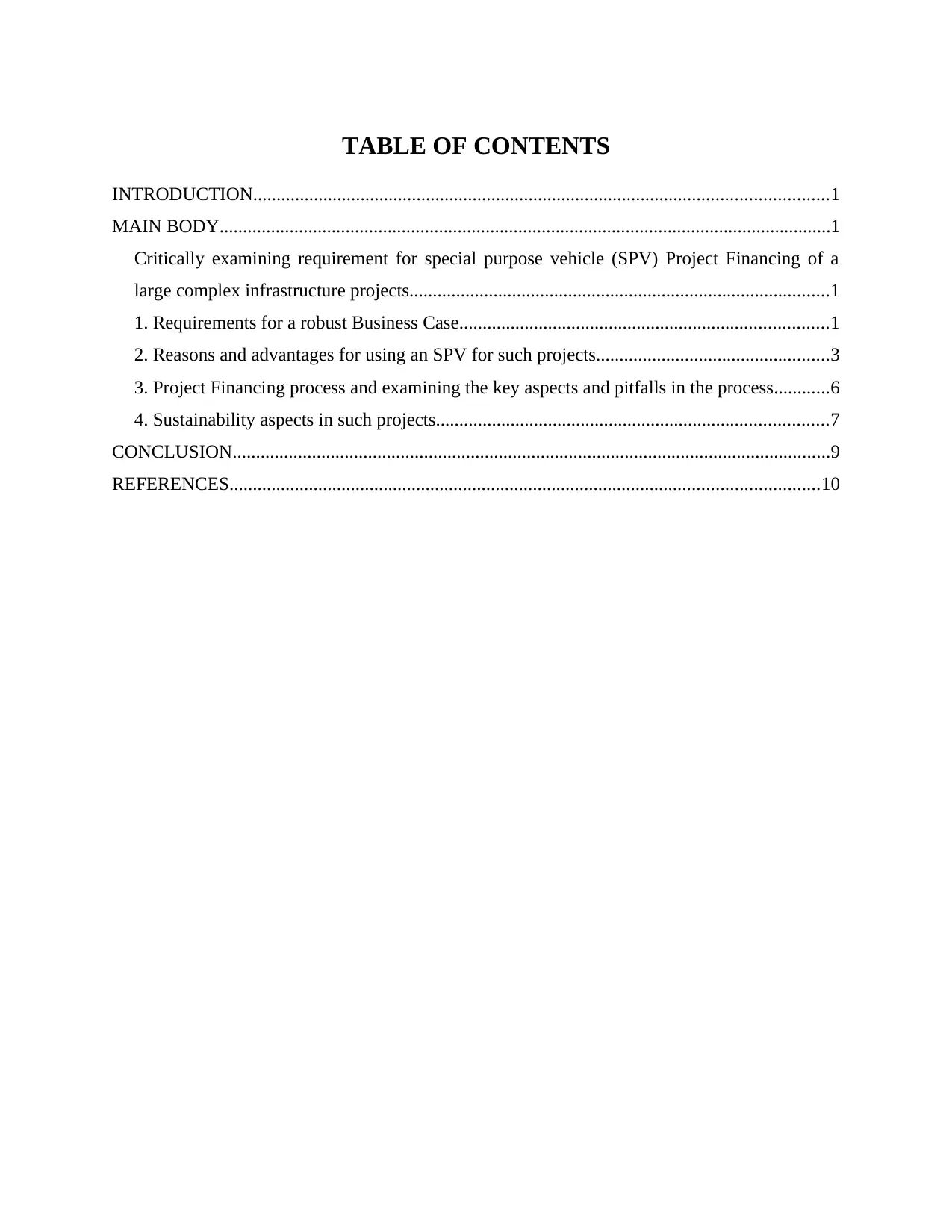
TABLE OF CONTENTS
INTRODUCTION...........................................................................................................................1
MAIN BODY...................................................................................................................................1
Critically examining requirement for special purpose vehicle (SPV) Project Financing of a
large complex infrastructure projects..........................................................................................1
1. Requirements for a robust Business Case...............................................................................1
2. Reasons and advantages for using an SPV for such projects..................................................3
3. Project Financing process and examining the key aspects and pitfalls in the process............6
4. Sustainability aspects in such projects....................................................................................7
CONCLUSION................................................................................................................................9
REFERENCES..............................................................................................................................10
INTRODUCTION...........................................................................................................................1
MAIN BODY...................................................................................................................................1
Critically examining requirement for special purpose vehicle (SPV) Project Financing of a
large complex infrastructure projects..........................................................................................1
1. Requirements for a robust Business Case...............................................................................1
2. Reasons and advantages for using an SPV for such projects..................................................3
3. Project Financing process and examining the key aspects and pitfalls in the process............6
4. Sustainability aspects in such projects....................................................................................7
CONCLUSION................................................................................................................................9
REFERENCES..............................................................................................................................10
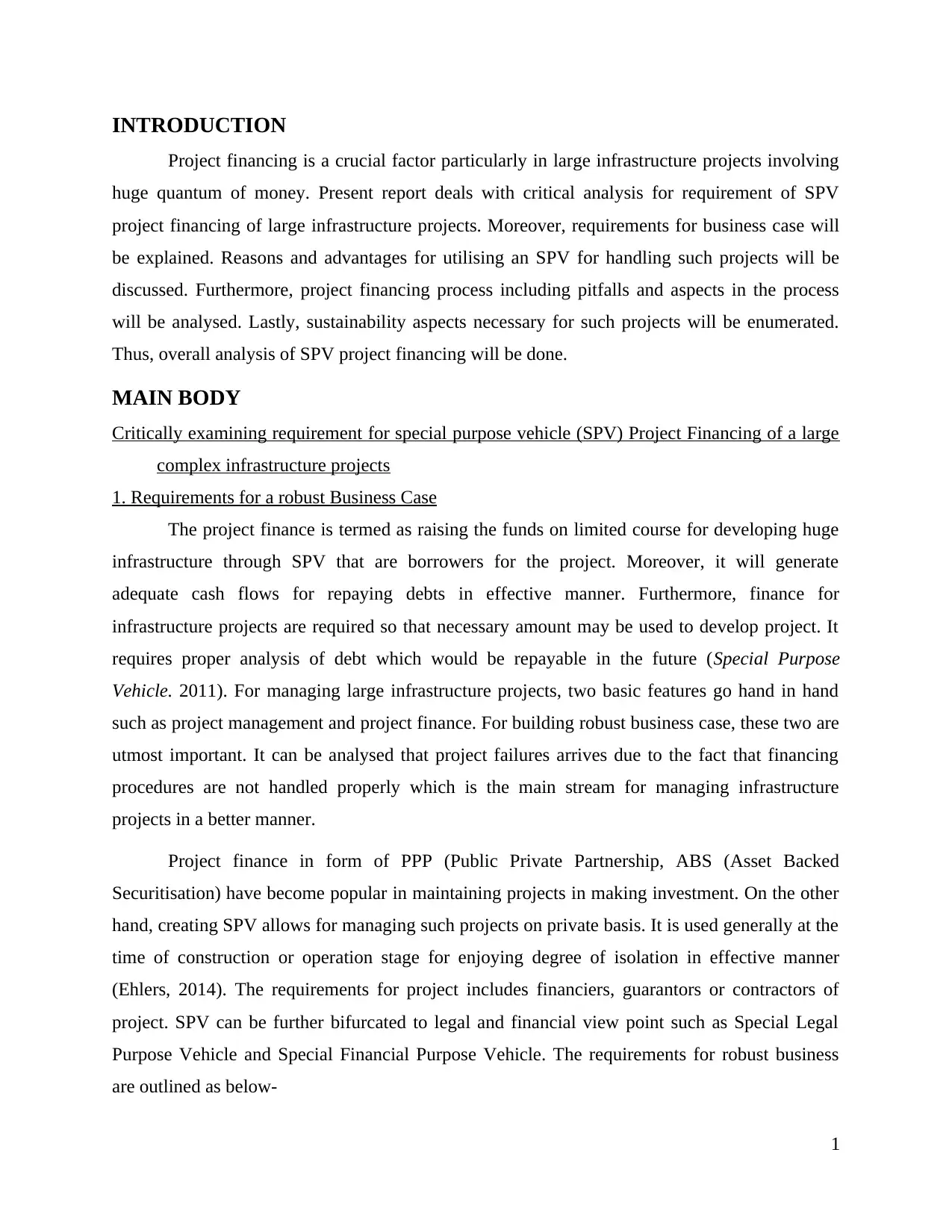
INTRODUCTION
Project financing is a crucial factor particularly in large infrastructure projects involving
huge quantum of money. Present report deals with critical analysis for requirement of SPV
project financing of large infrastructure projects. Moreover, requirements for business case will
be explained. Reasons and advantages for utilising an SPV for handling such projects will be
discussed. Furthermore, project financing process including pitfalls and aspects in the process
will be analysed. Lastly, sustainability aspects necessary for such projects will be enumerated.
Thus, overall analysis of SPV project financing will be done.
MAIN BODY
Critically examining requirement for special purpose vehicle (SPV) Project Financing of a large
complex infrastructure projects
1. Requirements for a robust Business Case
The project finance is termed as raising the funds on limited course for developing huge
infrastructure through SPV that are borrowers for the project. Moreover, it will generate
adequate cash flows for repaying debts in effective manner. Furthermore, finance for
infrastructure projects are required so that necessary amount may be used to develop project. It
requires proper analysis of debt which would be repayable in the future (Special Purpose
Vehicle. 2011). For managing large infrastructure projects, two basic features go hand in hand
such as project management and project finance. For building robust business case, these two are
utmost important. It can be analysed that project failures arrives due to the fact that financing
procedures are not handled properly which is the main stream for managing infrastructure
projects in a better manner.
Project finance in form of PPP (Public Private Partnership, ABS (Asset Backed
Securitisation) have become popular in maintaining projects in making investment. On the other
hand, creating SPV allows for managing such projects on private basis. It is used generally at the
time of construction or operation stage for enjoying degree of isolation in effective manner
(Ehlers, 2014). The requirements for project includes financiers, guarantors or contractors of
project. SPV can be further bifurcated to legal and financial view point such as Special Legal
Purpose Vehicle and Special Financial Purpose Vehicle. The requirements for robust business
are outlined as below-
1
Project financing is a crucial factor particularly in large infrastructure projects involving
huge quantum of money. Present report deals with critical analysis for requirement of SPV
project financing of large infrastructure projects. Moreover, requirements for business case will
be explained. Reasons and advantages for utilising an SPV for handling such projects will be
discussed. Furthermore, project financing process including pitfalls and aspects in the process
will be analysed. Lastly, sustainability aspects necessary for such projects will be enumerated.
Thus, overall analysis of SPV project financing will be done.
MAIN BODY
Critically examining requirement for special purpose vehicle (SPV) Project Financing of a large
complex infrastructure projects
1. Requirements for a robust Business Case
The project finance is termed as raising the funds on limited course for developing huge
infrastructure through SPV that are borrowers for the project. Moreover, it will generate
adequate cash flows for repaying debts in effective manner. Furthermore, finance for
infrastructure projects are required so that necessary amount may be used to develop project. It
requires proper analysis of debt which would be repayable in the future (Special Purpose
Vehicle. 2011). For managing large infrastructure projects, two basic features go hand in hand
such as project management and project finance. For building robust business case, these two are
utmost important. It can be analysed that project failures arrives due to the fact that financing
procedures are not handled properly which is the main stream for managing infrastructure
projects in a better manner.
Project finance in form of PPP (Public Private Partnership, ABS (Asset Backed
Securitisation) have become popular in maintaining projects in making investment. On the other
hand, creating SPV allows for managing such projects on private basis. It is used generally at the
time of construction or operation stage for enjoying degree of isolation in effective manner
(Ehlers, 2014). The requirements for project includes financiers, guarantors or contractors of
project. SPV can be further bifurcated to legal and financial view point such as Special Legal
Purpose Vehicle and Special Financial Purpose Vehicle. The requirements for robust business
are outlined as below-
1
⊘ This is a preview!⊘
Do you want full access?
Subscribe today to unlock all pages.

Trusted by 1+ million students worldwide
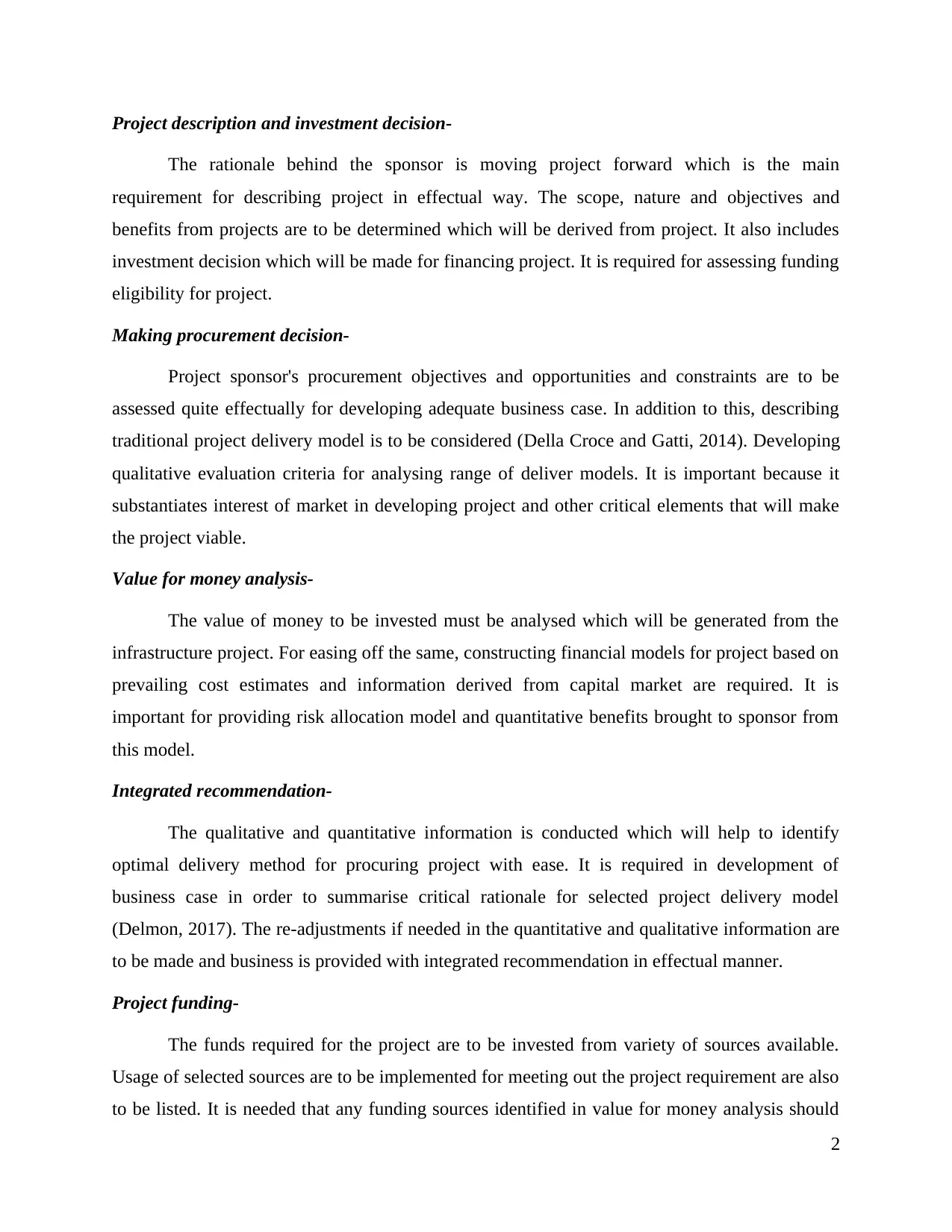
Project description and investment decision-
The rationale behind the sponsor is moving project forward which is the main
requirement for describing project in effectual way. The scope, nature and objectives and
benefits from projects are to be determined which will be derived from project. It also includes
investment decision which will be made for financing project. It is required for assessing funding
eligibility for project.
Making procurement decision-
Project sponsor's procurement objectives and opportunities and constraints are to be
assessed quite effectually for developing adequate business case. In addition to this, describing
traditional project delivery model is to be considered (Della Croce and Gatti, 2014). Developing
qualitative evaluation criteria for analysing range of deliver models. It is important because it
substantiates interest of market in developing project and other critical elements that will make
the project viable.
Value for money analysis-
The value of money to be invested must be analysed which will be generated from the
infrastructure project. For easing off the same, constructing financial models for project based on
prevailing cost estimates and information derived from capital market are required. It is
important for providing risk allocation model and quantitative benefits brought to sponsor from
this model.
Integrated recommendation-
The qualitative and quantitative information is conducted which will help to identify
optimal delivery method for procuring project with ease. It is required in development of
business case in order to summarise critical rationale for selected project delivery model
(Delmon, 2017). The re-adjustments if needed in the quantitative and qualitative information are
to be made and business is provided with integrated recommendation in effectual manner.
Project funding-
The funds required for the project are to be invested from variety of sources available.
Usage of selected sources are to be implemented for meeting out the project requirement are also
to be listed. It is needed that any funding sources identified in value for money analysis should
2
The rationale behind the sponsor is moving project forward which is the main
requirement for describing project in effectual way. The scope, nature and objectives and
benefits from projects are to be determined which will be derived from project. It also includes
investment decision which will be made for financing project. It is required for assessing funding
eligibility for project.
Making procurement decision-
Project sponsor's procurement objectives and opportunities and constraints are to be
assessed quite effectually for developing adequate business case. In addition to this, describing
traditional project delivery model is to be considered (Della Croce and Gatti, 2014). Developing
qualitative evaluation criteria for analysing range of deliver models. It is important because it
substantiates interest of market in developing project and other critical elements that will make
the project viable.
Value for money analysis-
The value of money to be invested must be analysed which will be generated from the
infrastructure project. For easing off the same, constructing financial models for project based on
prevailing cost estimates and information derived from capital market are required. It is
important for providing risk allocation model and quantitative benefits brought to sponsor from
this model.
Integrated recommendation-
The qualitative and quantitative information is conducted which will help to identify
optimal delivery method for procuring project with ease. It is required in development of
business case in order to summarise critical rationale for selected project delivery model
(Delmon, 2017). The re-adjustments if needed in the quantitative and qualitative information are
to be made and business is provided with integrated recommendation in effectual manner.
Project funding-
The funds required for the project are to be invested from variety of sources available.
Usage of selected sources are to be implemented for meeting out the project requirement are also
to be listed. It is needed that any funding sources identified in value for money analysis should
2
Paraphrase This Document
Need a fresh take? Get an instant paraphrase of this document with our AI Paraphraser
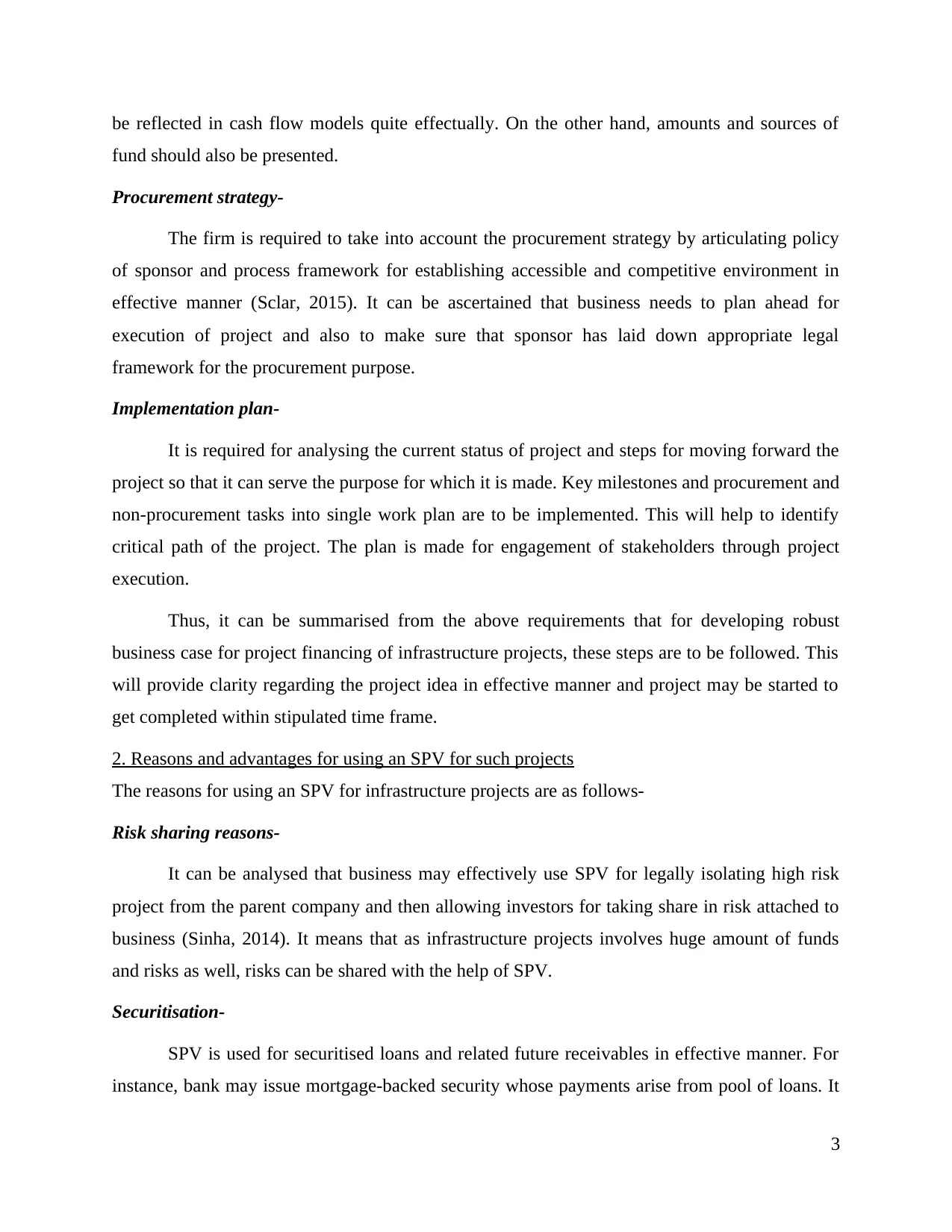
be reflected in cash flow models quite effectually. On the other hand, amounts and sources of
fund should also be presented.
Procurement strategy-
The firm is required to take into account the procurement strategy by articulating policy
of sponsor and process framework for establishing accessible and competitive environment in
effective manner (Sclar, 2015). It can be ascertained that business needs to plan ahead for
execution of project and also to make sure that sponsor has laid down appropriate legal
framework for the procurement purpose.
Implementation plan-
It is required for analysing the current status of project and steps for moving forward the
project so that it can serve the purpose for which it is made. Key milestones and procurement and
non-procurement tasks into single work plan are to be implemented. This will help to identify
critical path of the project. The plan is made for engagement of stakeholders through project
execution.
Thus, it can be summarised from the above requirements that for developing robust
business case for project financing of infrastructure projects, these steps are to be followed. This
will provide clarity regarding the project idea in effective manner and project may be started to
get completed within stipulated time frame.
2. Reasons and advantages for using an SPV for such projects
The reasons for using an SPV for infrastructure projects are as follows-
Risk sharing reasons-
It can be analysed that business may effectively use SPV for legally isolating high risk
project from the parent company and then allowing investors for taking share in risk attached to
business (Sinha, 2014). It means that as infrastructure projects involves huge amount of funds
and risks as well, risks can be shared with the help of SPV.
Securitisation-
SPV is used for securitised loans and related future receivables in effective manner. For
instance, bank may issue mortgage-backed security whose payments arise from pool of loans. It
3
fund should also be presented.
Procurement strategy-
The firm is required to take into account the procurement strategy by articulating policy
of sponsor and process framework for establishing accessible and competitive environment in
effective manner (Sclar, 2015). It can be ascertained that business needs to plan ahead for
execution of project and also to make sure that sponsor has laid down appropriate legal
framework for the procurement purpose.
Implementation plan-
It is required for analysing the current status of project and steps for moving forward the
project so that it can serve the purpose for which it is made. Key milestones and procurement and
non-procurement tasks into single work plan are to be implemented. This will help to identify
critical path of the project. The plan is made for engagement of stakeholders through project
execution.
Thus, it can be summarised from the above requirements that for developing robust
business case for project financing of infrastructure projects, these steps are to be followed. This
will provide clarity regarding the project idea in effective manner and project may be started to
get completed within stipulated time frame.
2. Reasons and advantages for using an SPV for such projects
The reasons for using an SPV for infrastructure projects are as follows-
Risk sharing reasons-
It can be analysed that business may effectively use SPV for legally isolating high risk
project from the parent company and then allowing investors for taking share in risk attached to
business (Sinha, 2014). It means that as infrastructure projects involves huge amount of funds
and risks as well, risks can be shared with the help of SPV.
Securitisation-
SPV is used for securitised loans and related future receivables in effective manner. For
instance, bank may issue mortgage-backed security whose payments arise from pool of loans. It
3
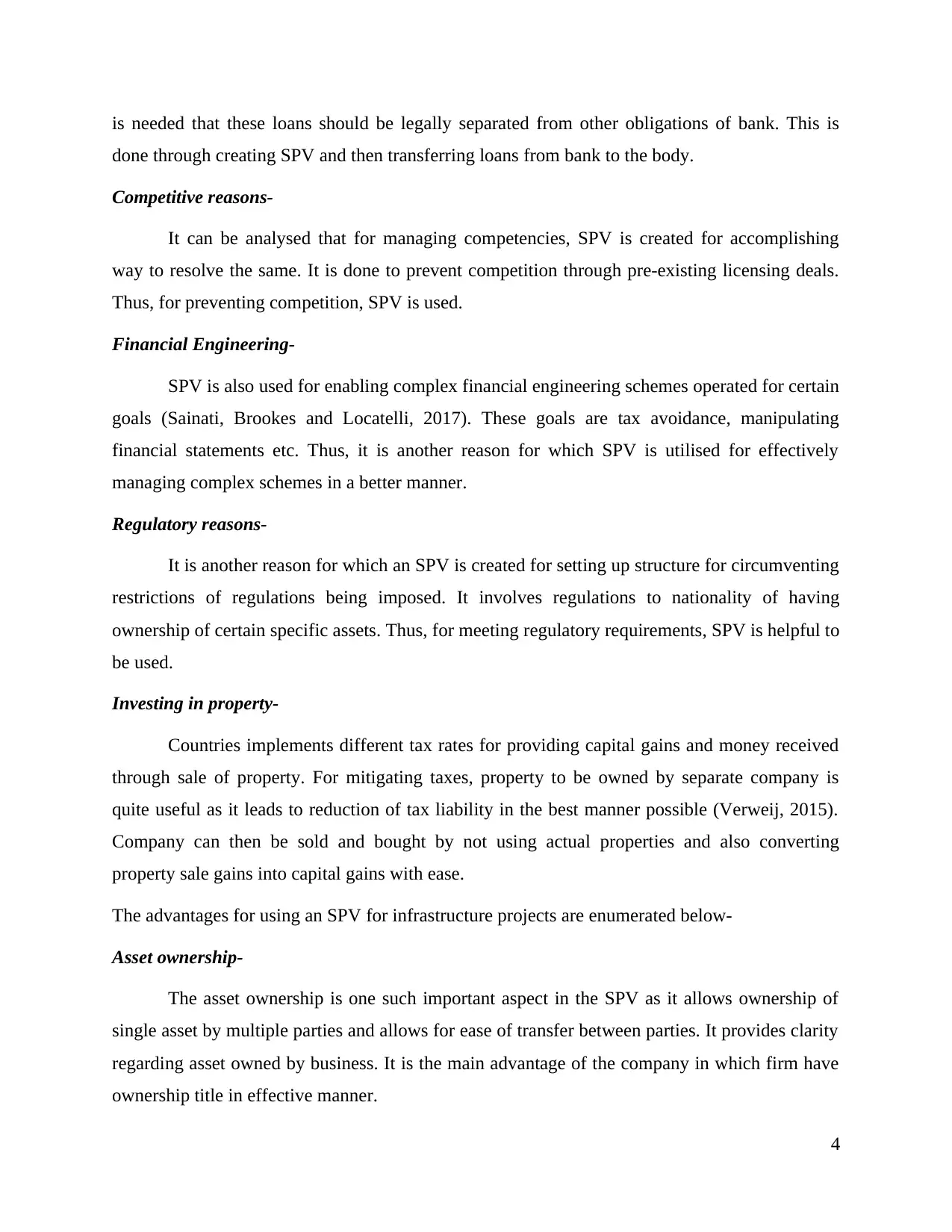
is needed that these loans should be legally separated from other obligations of bank. This is
done through creating SPV and then transferring loans from bank to the body.
Competitive reasons-
It can be analysed that for managing competencies, SPV is created for accomplishing
way to resolve the same. It is done to prevent competition through pre-existing licensing deals.
Thus, for preventing competition, SPV is used.
Financial Engineering-
SPV is also used for enabling complex financial engineering schemes operated for certain
goals (Sainati, Brookes and Locatelli, 2017). These goals are tax avoidance, manipulating
financial statements etc. Thus, it is another reason for which SPV is utilised for effectively
managing complex schemes in a better manner.
Regulatory reasons-
It is another reason for which an SPV is created for setting up structure for circumventing
restrictions of regulations being imposed. It involves regulations to nationality of having
ownership of certain specific assets. Thus, for meeting regulatory requirements, SPV is helpful to
be used.
Investing in property-
Countries implements different tax rates for providing capital gains and money received
through sale of property. For mitigating taxes, property to be owned by separate company is
quite useful as it leads to reduction of tax liability in the best manner possible (Verweij, 2015).
Company can then be sold and bought by not using actual properties and also converting
property sale gains into capital gains with ease.
The advantages for using an SPV for infrastructure projects are enumerated below-
Asset ownership-
The asset ownership is one such important aspect in the SPV as it allows ownership of
single asset by multiple parties and allows for ease of transfer between parties. It provides clarity
regarding asset owned by business. It is the main advantage of the company in which firm have
ownership title in effective manner.
4
done through creating SPV and then transferring loans from bank to the body.
Competitive reasons-
It can be analysed that for managing competencies, SPV is created for accomplishing
way to resolve the same. It is done to prevent competition through pre-existing licensing deals.
Thus, for preventing competition, SPV is used.
Financial Engineering-
SPV is also used for enabling complex financial engineering schemes operated for certain
goals (Sainati, Brookes and Locatelli, 2017). These goals are tax avoidance, manipulating
financial statements etc. Thus, it is another reason for which SPV is utilised for effectively
managing complex schemes in a better manner.
Regulatory reasons-
It is another reason for which an SPV is created for setting up structure for circumventing
restrictions of regulations being imposed. It involves regulations to nationality of having
ownership of certain specific assets. Thus, for meeting regulatory requirements, SPV is helpful to
be used.
Investing in property-
Countries implements different tax rates for providing capital gains and money received
through sale of property. For mitigating taxes, property to be owned by separate company is
quite useful as it leads to reduction of tax liability in the best manner possible (Verweij, 2015).
Company can then be sold and bought by not using actual properties and also converting
property sale gains into capital gains with ease.
The advantages for using an SPV for infrastructure projects are enumerated below-
Asset ownership-
The asset ownership is one such important aspect in the SPV as it allows ownership of
single asset by multiple parties and allows for ease of transfer between parties. It provides clarity
regarding asset owned by business. It is the main advantage of the company in which firm have
ownership title in effective manner.
4
⊘ This is a preview!⊘
Do you want full access?
Subscribe today to unlock all pages.

Trusted by 1+ million students worldwide
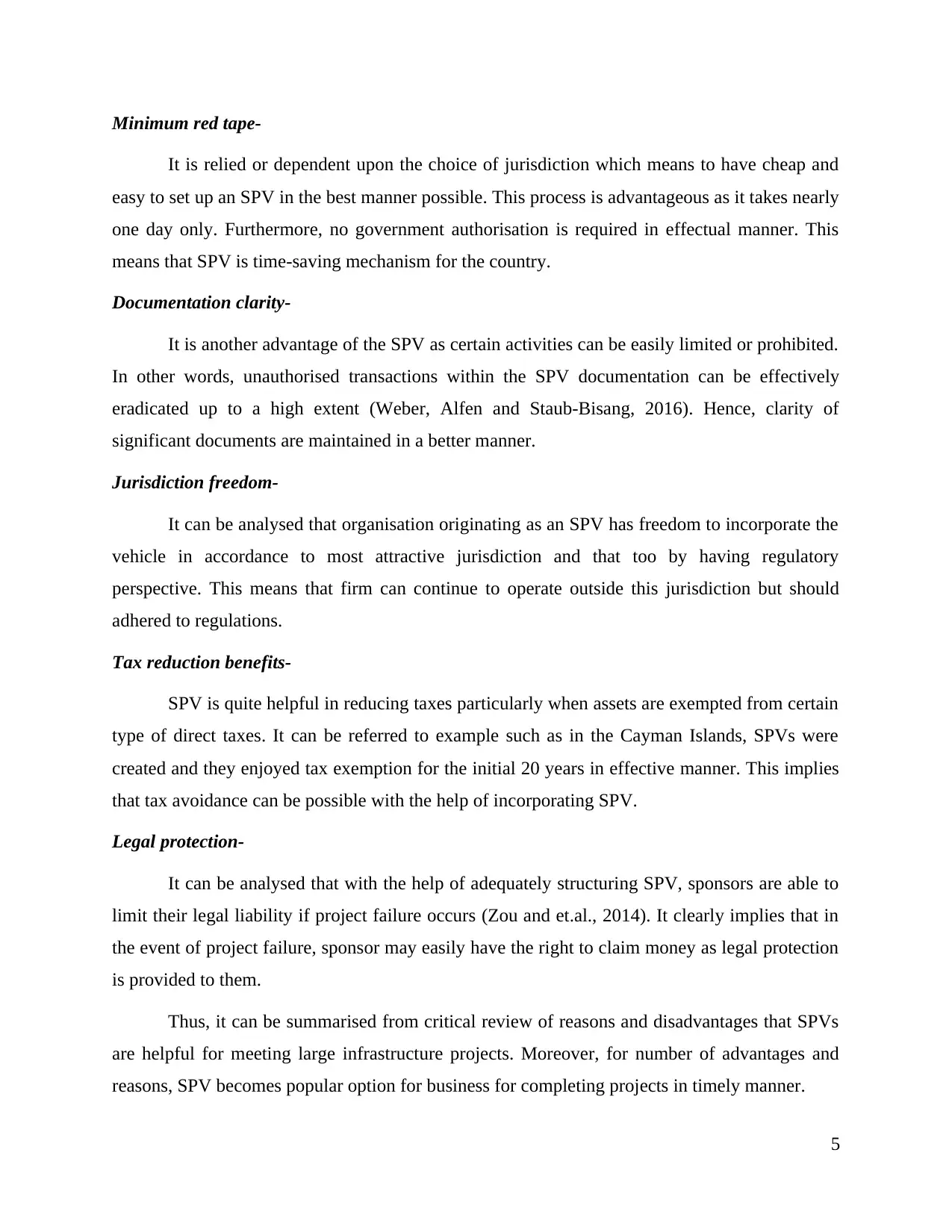
Minimum red tape-
It is relied or dependent upon the choice of jurisdiction which means to have cheap and
easy to set up an SPV in the best manner possible. This process is advantageous as it takes nearly
one day only. Furthermore, no government authorisation is required in effectual manner. This
means that SPV is time-saving mechanism for the country.
Documentation clarity-
It is another advantage of the SPV as certain activities can be easily limited or prohibited.
In other words, unauthorised transactions within the SPV documentation can be effectively
eradicated up to a high extent (Weber, Alfen and Staub-Bisang, 2016). Hence, clarity of
significant documents are maintained in a better manner.
Jurisdiction freedom-
It can be analysed that organisation originating as an SPV has freedom to incorporate the
vehicle in accordance to most attractive jurisdiction and that too by having regulatory
perspective. This means that firm can continue to operate outside this jurisdiction but should
adhered to regulations.
Tax reduction benefits-
SPV is quite helpful in reducing taxes particularly when assets are exempted from certain
type of direct taxes. It can be referred to example such as in the Cayman Islands, SPVs were
created and they enjoyed tax exemption for the initial 20 years in effective manner. This implies
that tax avoidance can be possible with the help of incorporating SPV.
Legal protection-
It can be analysed that with the help of adequately structuring SPV, sponsors are able to
limit their legal liability if project failure occurs (Zou and et.al., 2014). It clearly implies that in
the event of project failure, sponsor may easily have the right to claim money as legal protection
is provided to them.
Thus, it can be summarised from critical review of reasons and disadvantages that SPVs
are helpful for meeting large infrastructure projects. Moreover, for number of advantages and
reasons, SPV becomes popular option for business for completing projects in timely manner.
5
It is relied or dependent upon the choice of jurisdiction which means to have cheap and
easy to set up an SPV in the best manner possible. This process is advantageous as it takes nearly
one day only. Furthermore, no government authorisation is required in effectual manner. This
means that SPV is time-saving mechanism for the country.
Documentation clarity-
It is another advantage of the SPV as certain activities can be easily limited or prohibited.
In other words, unauthorised transactions within the SPV documentation can be effectively
eradicated up to a high extent (Weber, Alfen and Staub-Bisang, 2016). Hence, clarity of
significant documents are maintained in a better manner.
Jurisdiction freedom-
It can be analysed that organisation originating as an SPV has freedom to incorporate the
vehicle in accordance to most attractive jurisdiction and that too by having regulatory
perspective. This means that firm can continue to operate outside this jurisdiction but should
adhered to regulations.
Tax reduction benefits-
SPV is quite helpful in reducing taxes particularly when assets are exempted from certain
type of direct taxes. It can be referred to example such as in the Cayman Islands, SPVs were
created and they enjoyed tax exemption for the initial 20 years in effective manner. This implies
that tax avoidance can be possible with the help of incorporating SPV.
Legal protection-
It can be analysed that with the help of adequately structuring SPV, sponsors are able to
limit their legal liability if project failure occurs (Zou and et.al., 2014). It clearly implies that in
the event of project failure, sponsor may easily have the right to claim money as legal protection
is provided to them.
Thus, it can be summarised from critical review of reasons and disadvantages that SPVs
are helpful for meeting large infrastructure projects. Moreover, for number of advantages and
reasons, SPV becomes popular option for business for completing projects in timely manner.
5
Paraphrase This Document
Need a fresh take? Get an instant paraphrase of this document with our AI Paraphraser
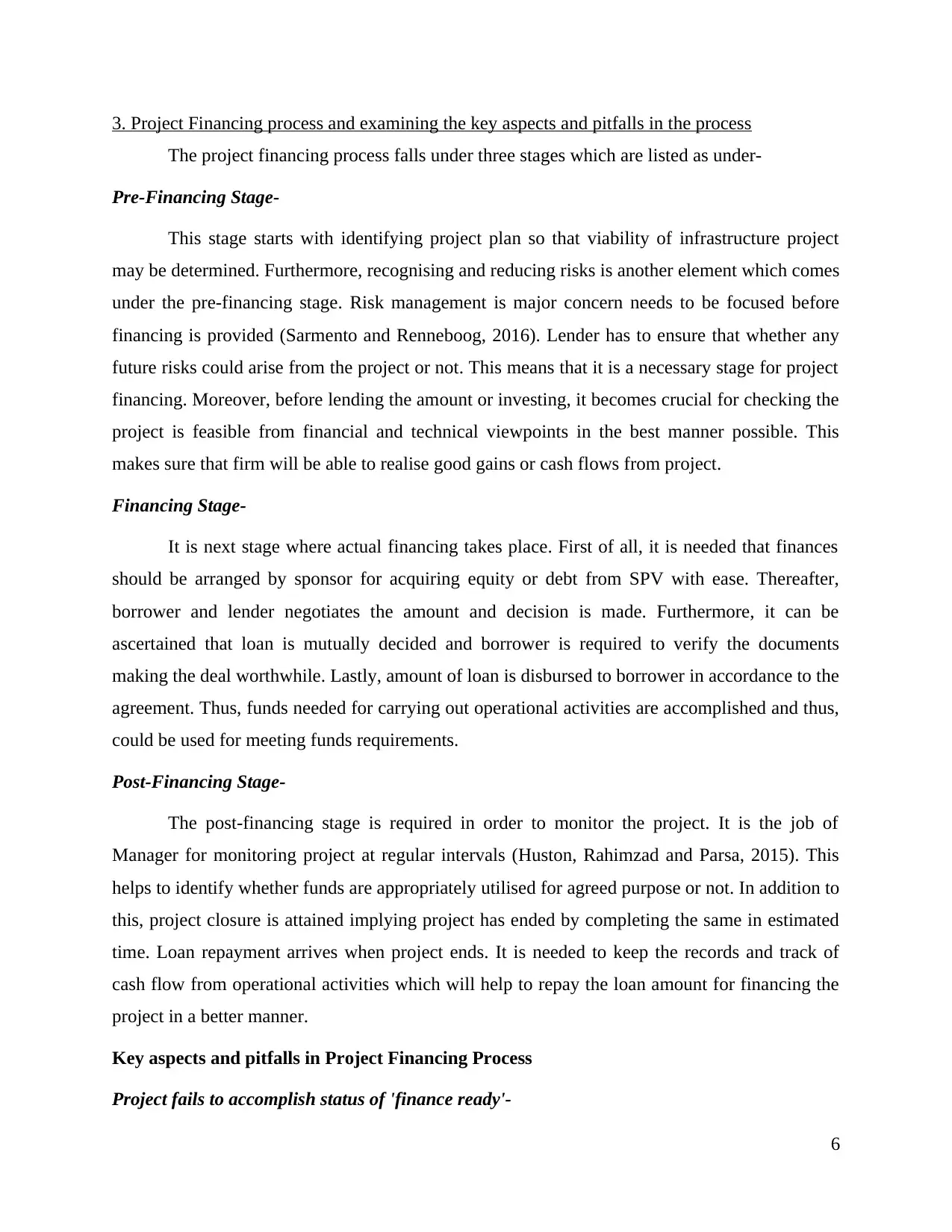
3. Project Financing process and examining the key aspects and pitfalls in the process
The project financing process falls under three stages which are listed as under-
Pre-Financing Stage-
This stage starts with identifying project plan so that viability of infrastructure project
may be determined. Furthermore, recognising and reducing risks is another element which comes
under the pre-financing stage. Risk management is major concern needs to be focused before
financing is provided (Sarmento and Renneboog, 2016). Lender has to ensure that whether any
future risks could arise from the project or not. This means that it is a necessary stage for project
financing. Moreover, before lending the amount or investing, it becomes crucial for checking the
project is feasible from financial and technical viewpoints in the best manner possible. This
makes sure that firm will be able to realise good gains or cash flows from project.
Financing Stage-
It is next stage where actual financing takes place. First of all, it is needed that finances
should be arranged by sponsor for acquiring equity or debt from SPV with ease. Thereafter,
borrower and lender negotiates the amount and decision is made. Furthermore, it can be
ascertained that loan is mutually decided and borrower is required to verify the documents
making the deal worthwhile. Lastly, amount of loan is disbursed to borrower in accordance to the
agreement. Thus, funds needed for carrying out operational activities are accomplished and thus,
could be used for meeting funds requirements.
Post-Financing Stage-
The post-financing stage is required in order to monitor the project. It is the job of
Manager for monitoring project at regular intervals (Huston, Rahimzad and Parsa, 2015). This
helps to identify whether funds are appropriately utilised for agreed purpose or not. In addition to
this, project closure is attained implying project has ended by completing the same in estimated
time. Loan repayment arrives when project ends. It is needed to keep the records and track of
cash flow from operational activities which will help to repay the loan amount for financing the
project in a better manner.
Key aspects and pitfalls in Project Financing Process
Project fails to accomplish status of 'finance ready'-
6
The project financing process falls under three stages which are listed as under-
Pre-Financing Stage-
This stage starts with identifying project plan so that viability of infrastructure project
may be determined. Furthermore, recognising and reducing risks is another element which comes
under the pre-financing stage. Risk management is major concern needs to be focused before
financing is provided (Sarmento and Renneboog, 2016). Lender has to ensure that whether any
future risks could arise from the project or not. This means that it is a necessary stage for project
financing. Moreover, before lending the amount or investing, it becomes crucial for checking the
project is feasible from financial and technical viewpoints in the best manner possible. This
makes sure that firm will be able to realise good gains or cash flows from project.
Financing Stage-
It is next stage where actual financing takes place. First of all, it is needed that finances
should be arranged by sponsor for acquiring equity or debt from SPV with ease. Thereafter,
borrower and lender negotiates the amount and decision is made. Furthermore, it can be
ascertained that loan is mutually decided and borrower is required to verify the documents
making the deal worthwhile. Lastly, amount of loan is disbursed to borrower in accordance to the
agreement. Thus, funds needed for carrying out operational activities are accomplished and thus,
could be used for meeting funds requirements.
Post-Financing Stage-
The post-financing stage is required in order to monitor the project. It is the job of
Manager for monitoring project at regular intervals (Huston, Rahimzad and Parsa, 2015). This
helps to identify whether funds are appropriately utilised for agreed purpose or not. In addition to
this, project closure is attained implying project has ended by completing the same in estimated
time. Loan repayment arrives when project ends. It is needed to keep the records and track of
cash flow from operational activities which will help to repay the loan amount for financing the
project in a better manner.
Key aspects and pitfalls in Project Financing Process
Project fails to accomplish status of 'finance ready'-
6
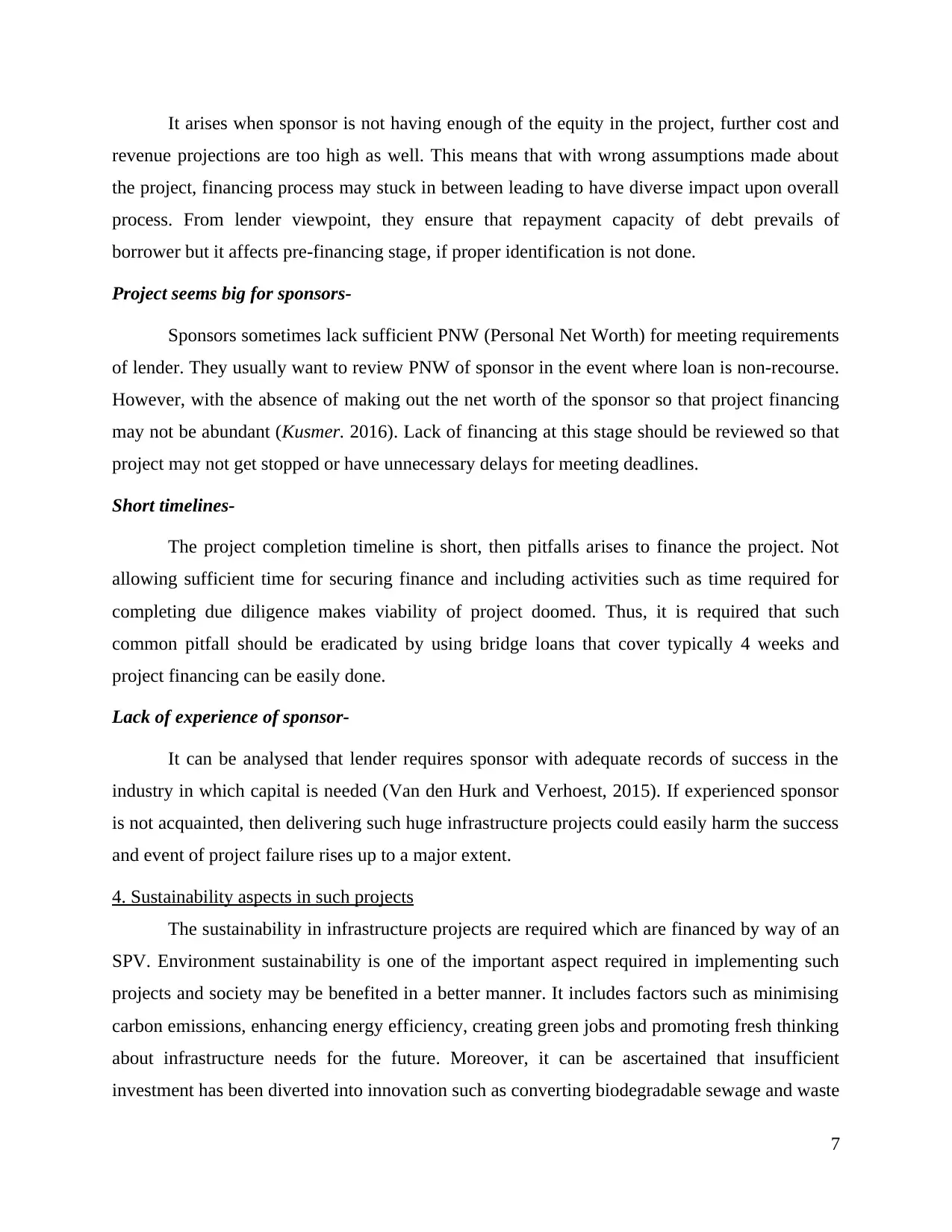
It arises when sponsor is not having enough of the equity in the project, further cost and
revenue projections are too high as well. This means that with wrong assumptions made about
the project, financing process may stuck in between leading to have diverse impact upon overall
process. From lender viewpoint, they ensure that repayment capacity of debt prevails of
borrower but it affects pre-financing stage, if proper identification is not done.
Project seems big for sponsors-
Sponsors sometimes lack sufficient PNW (Personal Net Worth) for meeting requirements
of lender. They usually want to review PNW of sponsor in the event where loan is non-recourse.
However, with the absence of making out the net worth of the sponsor so that project financing
may not be abundant (Kusmer. 2016). Lack of financing at this stage should be reviewed so that
project may not get stopped or have unnecessary delays for meeting deadlines.
Short timelines-
The project completion timeline is short, then pitfalls arises to finance the project. Not
allowing sufficient time for securing finance and including activities such as time required for
completing due diligence makes viability of project doomed. Thus, it is required that such
common pitfall should be eradicated by using bridge loans that cover typically 4 weeks and
project financing can be easily done.
Lack of experience of sponsor-
It can be analysed that lender requires sponsor with adequate records of success in the
industry in which capital is needed (Van den Hurk and Verhoest, 2015). If experienced sponsor
is not acquainted, then delivering such huge infrastructure projects could easily harm the success
and event of project failure rises up to a major extent.
4. Sustainability aspects in such projects
The sustainability in infrastructure projects are required which are financed by way of an
SPV. Environment sustainability is one of the important aspect required in implementing such
projects and society may be benefited in a better manner. It includes factors such as minimising
carbon emissions, enhancing energy efficiency, creating green jobs and promoting fresh thinking
about infrastructure needs for the future. Moreover, it can be ascertained that insufficient
investment has been diverted into innovation such as converting biodegradable sewage and waste
7
revenue projections are too high as well. This means that with wrong assumptions made about
the project, financing process may stuck in between leading to have diverse impact upon overall
process. From lender viewpoint, they ensure that repayment capacity of debt prevails of
borrower but it affects pre-financing stage, if proper identification is not done.
Project seems big for sponsors-
Sponsors sometimes lack sufficient PNW (Personal Net Worth) for meeting requirements
of lender. They usually want to review PNW of sponsor in the event where loan is non-recourse.
However, with the absence of making out the net worth of the sponsor so that project financing
may not be abundant (Kusmer. 2016). Lack of financing at this stage should be reviewed so that
project may not get stopped or have unnecessary delays for meeting deadlines.
Short timelines-
The project completion timeline is short, then pitfalls arises to finance the project. Not
allowing sufficient time for securing finance and including activities such as time required for
completing due diligence makes viability of project doomed. Thus, it is required that such
common pitfall should be eradicated by using bridge loans that cover typically 4 weeks and
project financing can be easily done.
Lack of experience of sponsor-
It can be analysed that lender requires sponsor with adequate records of success in the
industry in which capital is needed (Van den Hurk and Verhoest, 2015). If experienced sponsor
is not acquainted, then delivering such huge infrastructure projects could easily harm the success
and event of project failure rises up to a major extent.
4. Sustainability aspects in such projects
The sustainability in infrastructure projects are required which are financed by way of an
SPV. Environment sustainability is one of the important aspect required in implementing such
projects and society may be benefited in a better manner. It includes factors such as minimising
carbon emissions, enhancing energy efficiency, creating green jobs and promoting fresh thinking
about infrastructure needs for the future. Moreover, it can be ascertained that insufficient
investment has been diverted into innovation such as converting biodegradable sewage and waste
7
⊘ This is a preview!⊘
Do you want full access?
Subscribe today to unlock all pages.

Trusted by 1+ million students worldwide
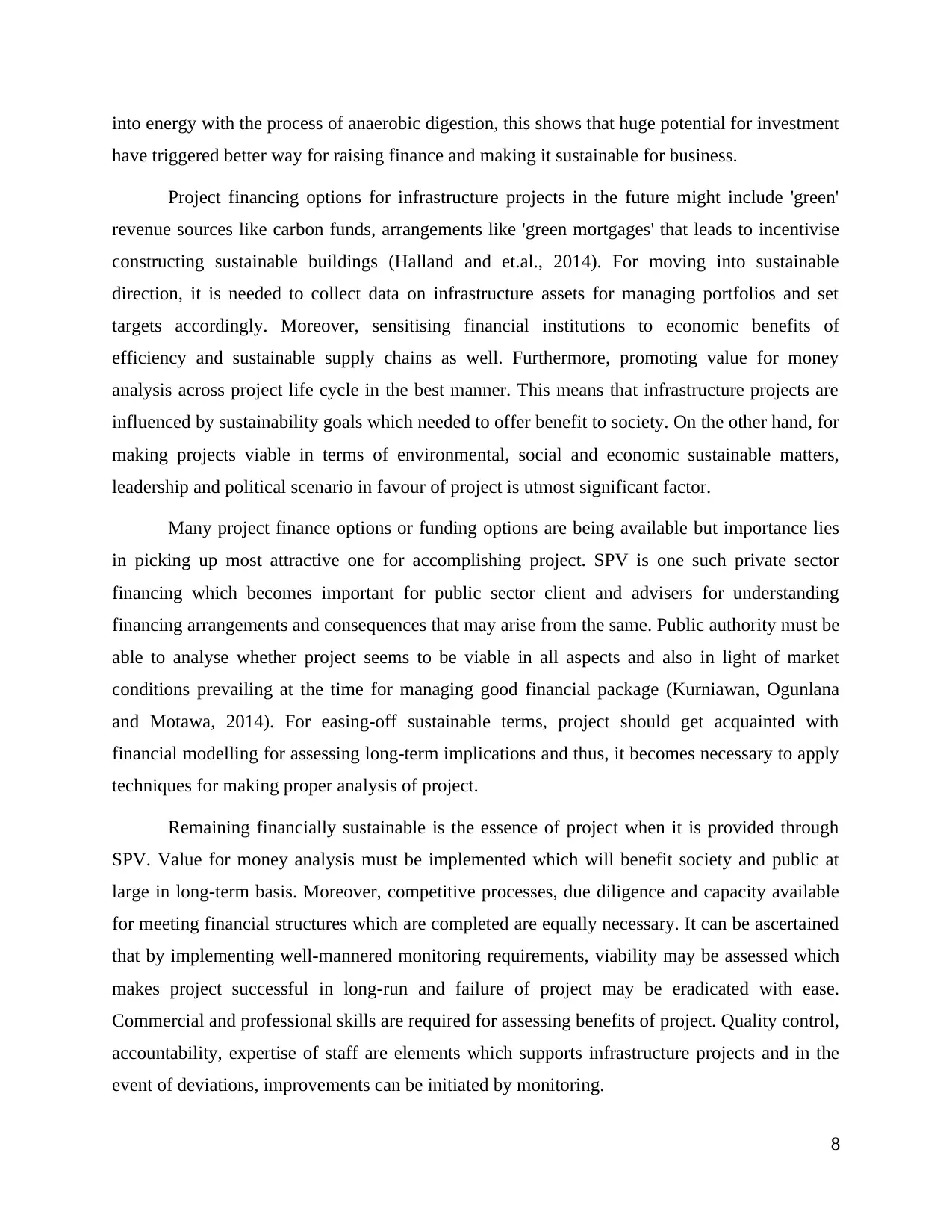
into energy with the process of anaerobic digestion, this shows that huge potential for investment
have triggered better way for raising finance and making it sustainable for business.
Project financing options for infrastructure projects in the future might include 'green'
revenue sources like carbon funds, arrangements like 'green mortgages' that leads to incentivise
constructing sustainable buildings (Halland and et.al., 2014). For moving into sustainable
direction, it is needed to collect data on infrastructure assets for managing portfolios and set
targets accordingly. Moreover, sensitising financial institutions to economic benefits of
efficiency and sustainable supply chains as well. Furthermore, promoting value for money
analysis across project life cycle in the best manner. This means that infrastructure projects are
influenced by sustainability goals which needed to offer benefit to society. On the other hand, for
making projects viable in terms of environmental, social and economic sustainable matters,
leadership and political scenario in favour of project is utmost significant factor.
Many project finance options or funding options are being available but importance lies
in picking up most attractive one for accomplishing project. SPV is one such private sector
financing which becomes important for public sector client and advisers for understanding
financing arrangements and consequences that may arise from the same. Public authority must be
able to analyse whether project seems to be viable in all aspects and also in light of market
conditions prevailing at the time for managing good financial package (Kurniawan, Ogunlana
and Motawa, 2014). For easing-off sustainable terms, project should get acquainted with
financial modelling for assessing long-term implications and thus, it becomes necessary to apply
techniques for making proper analysis of project.
Remaining financially sustainable is the essence of project when it is provided through
SPV. Value for money analysis must be implemented which will benefit society and public at
large in long-term basis. Moreover, competitive processes, due diligence and capacity available
for meeting financial structures which are completed are equally necessary. It can be ascertained
that by implementing well-mannered monitoring requirements, viability may be assessed which
makes project successful in long-run and failure of project may be eradicated with ease.
Commercial and professional skills are required for assessing benefits of project. Quality control,
accountability, expertise of staff are elements which supports infrastructure projects and in the
event of deviations, improvements can be initiated by monitoring.
8
have triggered better way for raising finance and making it sustainable for business.
Project financing options for infrastructure projects in the future might include 'green'
revenue sources like carbon funds, arrangements like 'green mortgages' that leads to incentivise
constructing sustainable buildings (Halland and et.al., 2014). For moving into sustainable
direction, it is needed to collect data on infrastructure assets for managing portfolios and set
targets accordingly. Moreover, sensitising financial institutions to economic benefits of
efficiency and sustainable supply chains as well. Furthermore, promoting value for money
analysis across project life cycle in the best manner. This means that infrastructure projects are
influenced by sustainability goals which needed to offer benefit to society. On the other hand, for
making projects viable in terms of environmental, social and economic sustainable matters,
leadership and political scenario in favour of project is utmost significant factor.
Many project finance options or funding options are being available but importance lies
in picking up most attractive one for accomplishing project. SPV is one such private sector
financing which becomes important for public sector client and advisers for understanding
financing arrangements and consequences that may arise from the same. Public authority must be
able to analyse whether project seems to be viable in all aspects and also in light of market
conditions prevailing at the time for managing good financial package (Kurniawan, Ogunlana
and Motawa, 2014). For easing-off sustainable terms, project should get acquainted with
financial modelling for assessing long-term implications and thus, it becomes necessary to apply
techniques for making proper analysis of project.
Remaining financially sustainable is the essence of project when it is provided through
SPV. Value for money analysis must be implemented which will benefit society and public at
large in long-term basis. Moreover, competitive processes, due diligence and capacity available
for meeting financial structures which are completed are equally necessary. It can be ascertained
that by implementing well-mannered monitoring requirements, viability may be assessed which
makes project successful in long-run and failure of project may be eradicated with ease.
Commercial and professional skills are required for assessing benefits of project. Quality control,
accountability, expertise of staff are elements which supports infrastructure projects and in the
event of deviations, improvements can be initiated by monitoring.
8
Paraphrase This Document
Need a fresh take? Get an instant paraphrase of this document with our AI Paraphraser
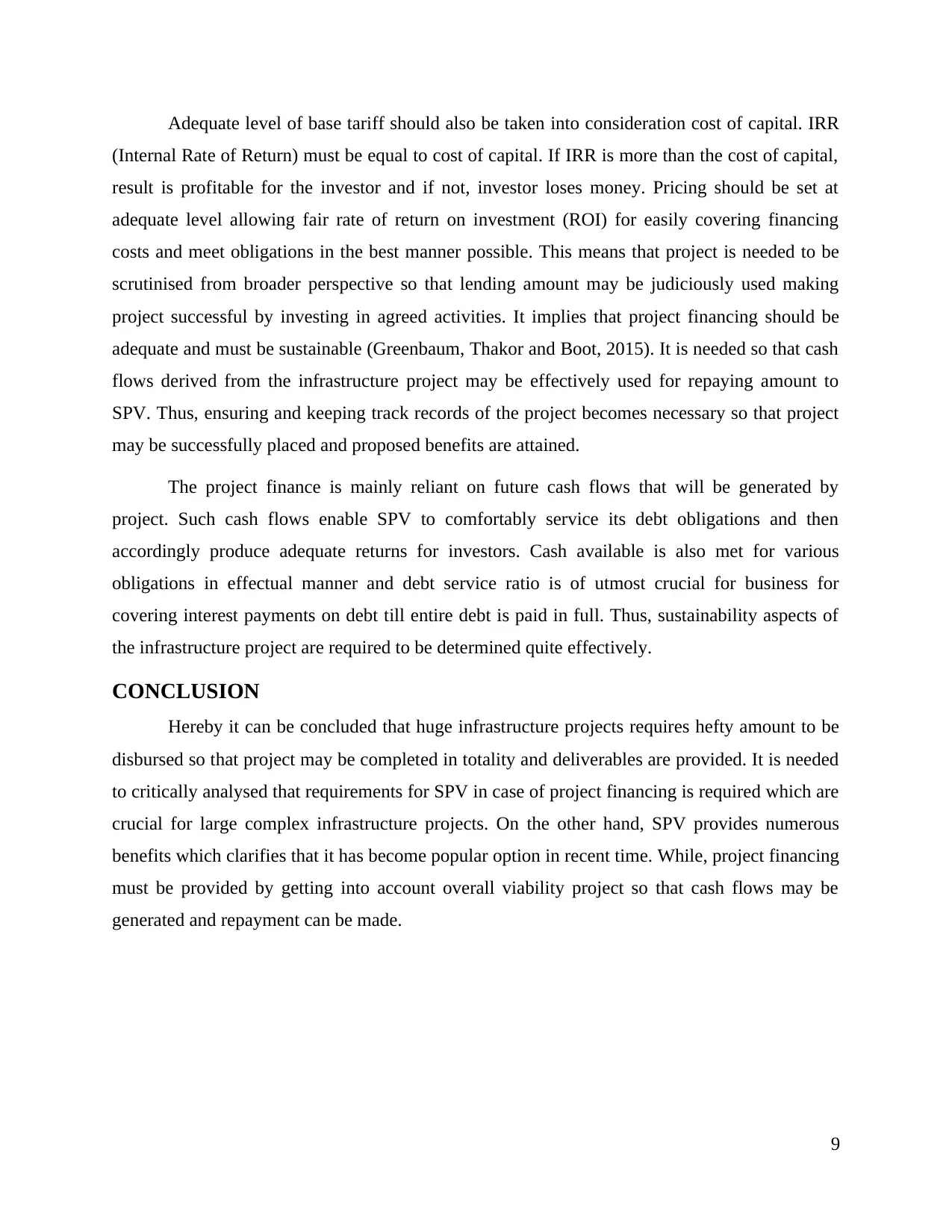
Adequate level of base tariff should also be taken into consideration cost of capital. IRR
(Internal Rate of Return) must be equal to cost of capital. If IRR is more than the cost of capital,
result is profitable for the investor and if not, investor loses money. Pricing should be set at
adequate level allowing fair rate of return on investment (ROI) for easily covering financing
costs and meet obligations in the best manner possible. This means that project is needed to be
scrutinised from broader perspective so that lending amount may be judiciously used making
project successful by investing in agreed activities. It implies that project financing should be
adequate and must be sustainable (Greenbaum, Thakor and Boot, 2015). It is needed so that cash
flows derived from the infrastructure project may be effectively used for repaying amount to
SPV. Thus, ensuring and keeping track records of the project becomes necessary so that project
may be successfully placed and proposed benefits are attained.
The project finance is mainly reliant on future cash flows that will be generated by
project. Such cash flows enable SPV to comfortably service its debt obligations and then
accordingly produce adequate returns for investors. Cash available is also met for various
obligations in effectual manner and debt service ratio is of utmost crucial for business for
covering interest payments on debt till entire debt is paid in full. Thus, sustainability aspects of
the infrastructure project are required to be determined quite effectively.
CONCLUSION
Hereby it can be concluded that huge infrastructure projects requires hefty amount to be
disbursed so that project may be completed in totality and deliverables are provided. It is needed
to critically analysed that requirements for SPV in case of project financing is required which are
crucial for large complex infrastructure projects. On the other hand, SPV provides numerous
benefits which clarifies that it has become popular option in recent time. While, project financing
must be provided by getting into account overall viability project so that cash flows may be
generated and repayment can be made.
9
(Internal Rate of Return) must be equal to cost of capital. If IRR is more than the cost of capital,
result is profitable for the investor and if not, investor loses money. Pricing should be set at
adequate level allowing fair rate of return on investment (ROI) for easily covering financing
costs and meet obligations in the best manner possible. This means that project is needed to be
scrutinised from broader perspective so that lending amount may be judiciously used making
project successful by investing in agreed activities. It implies that project financing should be
adequate and must be sustainable (Greenbaum, Thakor and Boot, 2015). It is needed so that cash
flows derived from the infrastructure project may be effectively used for repaying amount to
SPV. Thus, ensuring and keeping track records of the project becomes necessary so that project
may be successfully placed and proposed benefits are attained.
The project finance is mainly reliant on future cash flows that will be generated by
project. Such cash flows enable SPV to comfortably service its debt obligations and then
accordingly produce adequate returns for investors. Cash available is also met for various
obligations in effectual manner and debt service ratio is of utmost crucial for business for
covering interest payments on debt till entire debt is paid in full. Thus, sustainability aspects of
the infrastructure project are required to be determined quite effectively.
CONCLUSION
Hereby it can be concluded that huge infrastructure projects requires hefty amount to be
disbursed so that project may be completed in totality and deliverables are provided. It is needed
to critically analysed that requirements for SPV in case of project financing is required which are
crucial for large complex infrastructure projects. On the other hand, SPV provides numerous
benefits which clarifies that it has become popular option in recent time. While, project financing
must be provided by getting into account overall viability project so that cash flows may be
generated and repayment can be made.
9
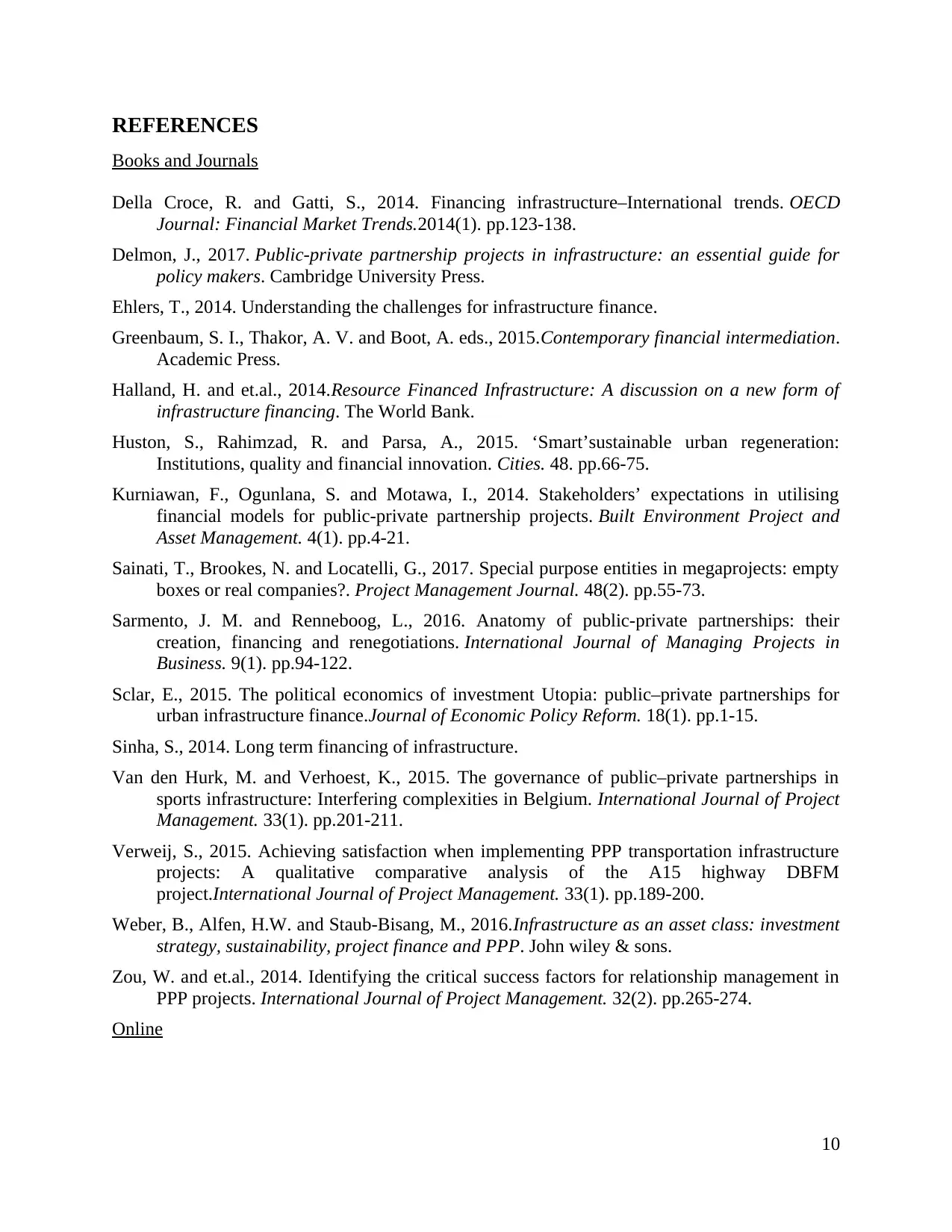
REFERENCES
Books and Journals
Della Croce, R. and Gatti, S., 2014. Financing infrastructure–International trends. OECD
Journal: Financial Market Trends.2014(1). pp.123-138.
Delmon, J., 2017. Public-private partnership projects in infrastructure: an essential guide for
policy makers. Cambridge University Press.
Ehlers, T., 2014. Understanding the challenges for infrastructure finance.
Greenbaum, S. I., Thakor, A. V. and Boot, A. eds., 2015.Contemporary financial intermediation.
Academic Press.
Halland, H. and et.al., 2014.Resource Financed Infrastructure: A discussion on a new form of
infrastructure financing. The World Bank.
Huston, S., Rahimzad, R. and Parsa, A., 2015. ‘Smart’sustainable urban regeneration:
Institutions, quality and financial innovation. Cities. 48. pp.66-75.
Kurniawan, F., Ogunlana, S. and Motawa, I., 2014. Stakeholders’ expectations in utilising
financial models for public-private partnership projects. Built Environment Project and
Asset Management. 4(1). pp.4-21.
Sainati, T., Brookes, N. and Locatelli, G., 2017. Special purpose entities in megaprojects: empty
boxes or real companies?. Project Management Journal. 48(2). pp.55-73.
Sarmento, J. M. and Renneboog, L., 2016. Anatomy of public-private partnerships: their
creation, financing and renegotiations. International Journal of Managing Projects in
Business. 9(1). pp.94-122.
Sclar, E., 2015. The political economics of investment Utopia: public–private partnerships for
urban infrastructure finance.Journal of Economic Policy Reform. 18(1). pp.1-15.
Sinha, S., 2014. Long term financing of infrastructure.
Van den Hurk, M. and Verhoest, K., 2015. The governance of public–private partnerships in
sports infrastructure: Interfering complexities in Belgium. International Journal of Project
Management. 33(1). pp.201-211.
Verweij, S., 2015. Achieving satisfaction when implementing PPP transportation infrastructure
projects: A qualitative comparative analysis of the A15 highway DBFM
project.International Journal of Project Management. 33(1). pp.189-200.
Weber, B., Alfen, H.W. and Staub-Bisang, M., 2016.Infrastructure as an asset class: investment
strategy, sustainability, project finance and PPP. John wiley & sons.
Zou, W. and et.al., 2014. Identifying the critical success factors for relationship management in
PPP projects. International Journal of Project Management. 32(2). pp.265-274.
Online
10
Books and Journals
Della Croce, R. and Gatti, S., 2014. Financing infrastructure–International trends. OECD
Journal: Financial Market Trends.2014(1). pp.123-138.
Delmon, J., 2017. Public-private partnership projects in infrastructure: an essential guide for
policy makers. Cambridge University Press.
Ehlers, T., 2014. Understanding the challenges for infrastructure finance.
Greenbaum, S. I., Thakor, A. V. and Boot, A. eds., 2015.Contemporary financial intermediation.
Academic Press.
Halland, H. and et.al., 2014.Resource Financed Infrastructure: A discussion on a new form of
infrastructure financing. The World Bank.
Huston, S., Rahimzad, R. and Parsa, A., 2015. ‘Smart’sustainable urban regeneration:
Institutions, quality and financial innovation. Cities. 48. pp.66-75.
Kurniawan, F., Ogunlana, S. and Motawa, I., 2014. Stakeholders’ expectations in utilising
financial models for public-private partnership projects. Built Environment Project and
Asset Management. 4(1). pp.4-21.
Sainati, T., Brookes, N. and Locatelli, G., 2017. Special purpose entities in megaprojects: empty
boxes or real companies?. Project Management Journal. 48(2). pp.55-73.
Sarmento, J. M. and Renneboog, L., 2016. Anatomy of public-private partnerships: their
creation, financing and renegotiations. International Journal of Managing Projects in
Business. 9(1). pp.94-122.
Sclar, E., 2015. The political economics of investment Utopia: public–private partnerships for
urban infrastructure finance.Journal of Economic Policy Reform. 18(1). pp.1-15.
Sinha, S., 2014. Long term financing of infrastructure.
Van den Hurk, M. and Verhoest, K., 2015. The governance of public–private partnerships in
sports infrastructure: Interfering complexities in Belgium. International Journal of Project
Management. 33(1). pp.201-211.
Verweij, S., 2015. Achieving satisfaction when implementing PPP transportation infrastructure
projects: A qualitative comparative analysis of the A15 highway DBFM
project.International Journal of Project Management. 33(1). pp.189-200.
Weber, B., Alfen, H.W. and Staub-Bisang, M., 2016.Infrastructure as an asset class: investment
strategy, sustainability, project finance and PPP. John wiley & sons.
Zou, W. and et.al., 2014. Identifying the critical success factors for relationship management in
PPP projects. International Journal of Project Management. 32(2). pp.265-274.
Online
10
⊘ This is a preview!⊘
Do you want full access?
Subscribe today to unlock all pages.

Trusted by 1+ million students worldwide
1 out of 13
Related Documents
Your All-in-One AI-Powered Toolkit for Academic Success.
+13062052269
info@desklib.com
Available 24*7 on WhatsApp / Email
![[object Object]](/_next/static/media/star-bottom.7253800d.svg)
Unlock your academic potential
Copyright © 2020–2025 A2Z Services. All Rights Reserved. Developed and managed by ZUCOL.




